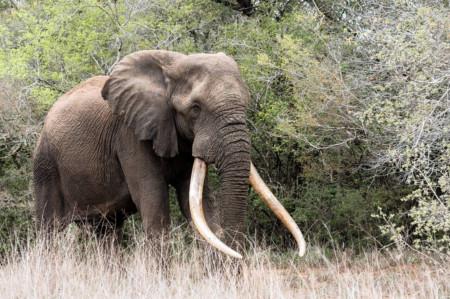By Tony Carnie
Pretoria News

With tusks almost 3m long, Makadebona was the second-largest tusker in Southern Africa. In Zulu his name meant One who has been around/seen it all.
The death of one of Southern Africa’s last big tuskers has sparked appeals for better protection of Africa’s dwindling number of large-tusked elephants, especially the unique ivory gene pool from KwaZulu-Natal’s Tembe Elephant Park.
Last week, field rangers in Tembe found the body of Makadebona, believed to be the second-largest tusker on the sub-continent. Aged around 45, the large bull had head wounds suggesting he was killed in a fight with a rival bull nearly a month ago.
According to Johan Marais, a Pretoria-based wildlife vet and author of two books on Africa’s largest tuskers, there are only about 40 bulls left in Africa which qualify as true tuskers – bulls whose tusks weigh more than 45kg each.
Makadebona’s left tusk was 2.71m long and weighed 58kg, while the right tusk was 2.65m long and weighed 53.5kg.
Until recently, the Tembe park had three of South Africa’s biggest tuskers. Although two of these bulls have died within the past two years, Tembe is still home to South Africa’s largest-known tusker, “iSilo”, a bull with tusks almost 3m long.
Marais said most of Africa’s biggest tuskers lived in Kenya’s Tsavo National Park, but in his opinion Tembe was the second best place to see large tuskers.
“Apart from East Africa, nowhere have I seen so many bulls with such magnificent ivory. Even in the Kruger National Park, the average bull carries much smaller ivory than the average bull in Tembe.”
Marais, who has travelled extensively across Africa to research his books on big tuskers, said tourists from the US and Europe were particularly keen to see and photograph unusually large bulls such as “Duke”, previously the largest bull in Kruger.
He noted that Africa’s elephant population had also plummeted to less than half a million, compared with five million elephants 65 years ago. Poaching and hunting pressure had all but wiped out the largest-tusked specimens.
“Now there are only 40 or so tuskers left throughout the continent and with the current level of ivory poaching, I’m worried if we don’t do something soon there will be no big tuskers left within 10 years…”
Marais said he was especially concerned about ensuring the survival of the Tembe elephant gene pool.
“Tsavo National Park in Kenya has more than 12 000 elephants, many with magnificent ivory, whereas Tembe is a very small park with only 230 elephants.”
Because the park was so small and also home to other unique plants and animals, the Tembe elephant population has been controlled artificially for the past six years using the porcine zona pellucida (PZP) contraceptive vaccine.
Marais said while he understood the biological reasons for contraception at Tembe, it was also essential to protect the gene pool of these large-tusked elephants in the park.
“The only solutions seem to be enlarging the park to give them more space, or to halt the contraception programme.”
Although there are plans to drop Tembe’s northern fence to allow the elephants to cross the border into Mozambique and link up with a related herd in the Maputo Elephant Special Reserve, Marais said it might be more practical to enlarge the Tembe park by linking it to the iSimangaliso Wetland Park or the Mkhuze and Ndumo game reserves in KZN.
“Elephant bulls only have a 20-year window to transfer their genes, between the ages of 35 and about 55 years. And they only come into musth (heightened sexual hormone levels) once a year, for about a month.”
Leonard Muller of Ezemvelo KZN Wildlife, who has been monitoring Tembe’s elephant population for the past four years, said Makadebona’s decomposed carcass had been found by field rangers last Monday in the Ezinaleni section of the park and he seemed to have died about a month ago.
Two years ago, another large bull “Induna” died in Tembe.
At the time, Makadebona was thought to be the park’s third-largest tusker, but a post-mortem inspection showed that his tusks were larger and heavier than those of Induna.
“We think Makadebona was only about 45 years old, whereas bulls can live to around 55 or 60 years old.
“So he was comparatively young and we know that tusks grow exponentially in the last few years of an elephant’s life,” said Muller.
So if he had not died prematurely, Makadebona would have developed really, really big ivory.
“Makadebona was my favourite elephant. He was just such a well-mannered, chilled and beautiful animal.”


